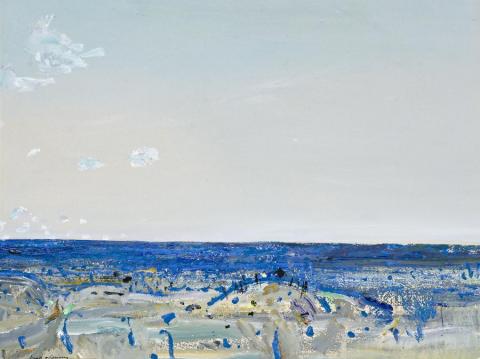AVENEL, c.1975
Fred Williams
gouache on paper
54.0 x 72.0 cm
signed lower left: Fred Williams
Joseph Brown Gallery, Melbourne
Private collection, New South Wales,
acquired from the above c.1975
There is a spontaneity about Fred Williams's gouaches that singles them out from the rest of his work. Painted outdoors directly from the motif, they have that freshness of first response, sparkling with light and atmospheric luminosity. Like drawing in paint, Williams explored the landscape and its potential for inspiring works. Sometimes painted in two or three strips on the one sheet of paper, or as a single view as in Avenel c1975, the images captured in gouaches were sometimes developed into oils in the more considered atmosphere of the artist's studio. Although often interrelated and worked as a series inspired by the You Yangs, Upwey, Bega, and the Hamersley landscape, his watercolours, prints and paintings, are entirely independent works. Moreover, although Williams wrote in his diary '...I only use the subject matter as an excuse to hang the picture on', his pictures combine a particular sense of place with that of the archetypal Australian landscape.1 The oil, Red Landscape 1981 in the collection of the National Gallery of Victoria, is as much a part of his Pilbara series as being quintessentially Australian. And again, the twelve-sheeted gouache, Bushfire in Northern Territory 1976, (collection National Gallery of Australia, Canberra), is the Australian bush on fire wherever the location.
So it is with the gouache Avenel, depicting a place that must have appealed to him for a number of reasons. First, it lies in the Victorian wine country of the Goulburn River Valley. There are also various historical interests, not the least being the rural town, once the childhood home of Ned Kelly. Settled in the 1830s, Henry Kent Hughes named his property 'Avenel' after a village in Gloucestershire, England. Vastness dominates in Williams's gouache, the majority of the painting given over to an immense expanse of sky - touching on the infinite. Working in the more traditional landscape format, infinity is echoed in the line of the horizon, which would seemingly stretch forever if it were not for the confines of the picture's space. Making a virtue of what others have seen as the monotony of the Australian landscape, Williams also reveals its intimate side. Although essentially an aerial view, through singular strokes of paint and scumbles of lyrical colour he reminds us of the detailed beauty that lies on the forest floor and in the endless varieties of eucalypt. From Avenel and Lysterfield to Weipa, herein lies the enchantment of our landscape and its unique interpreter.
1. Diary, 5 July 1970, quoted in Zdanowicz, I. & Coppel, S., Fred Williams: An Australian Vision, The British Museum Press, London, 2003, p. 99
DAVID THOMAS
